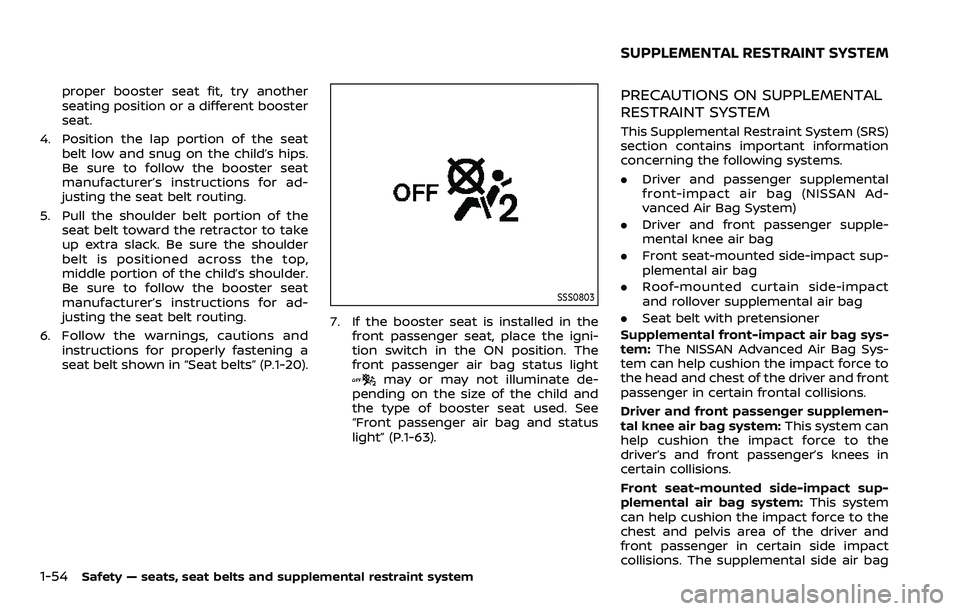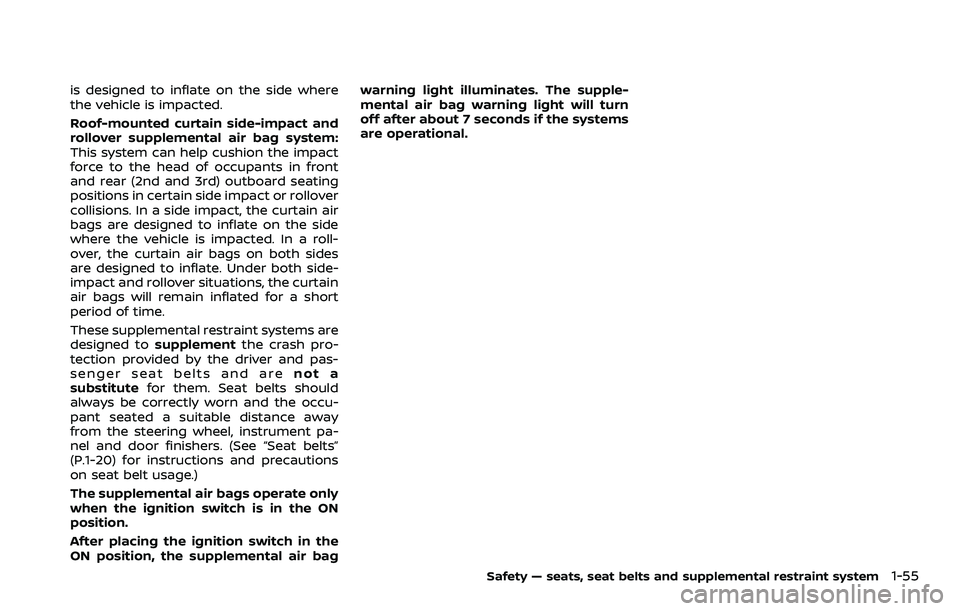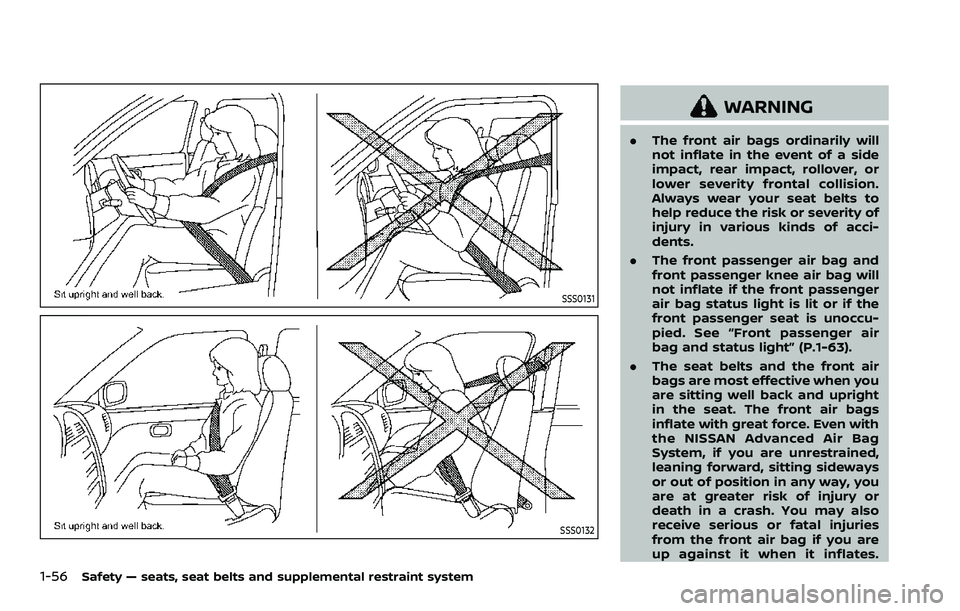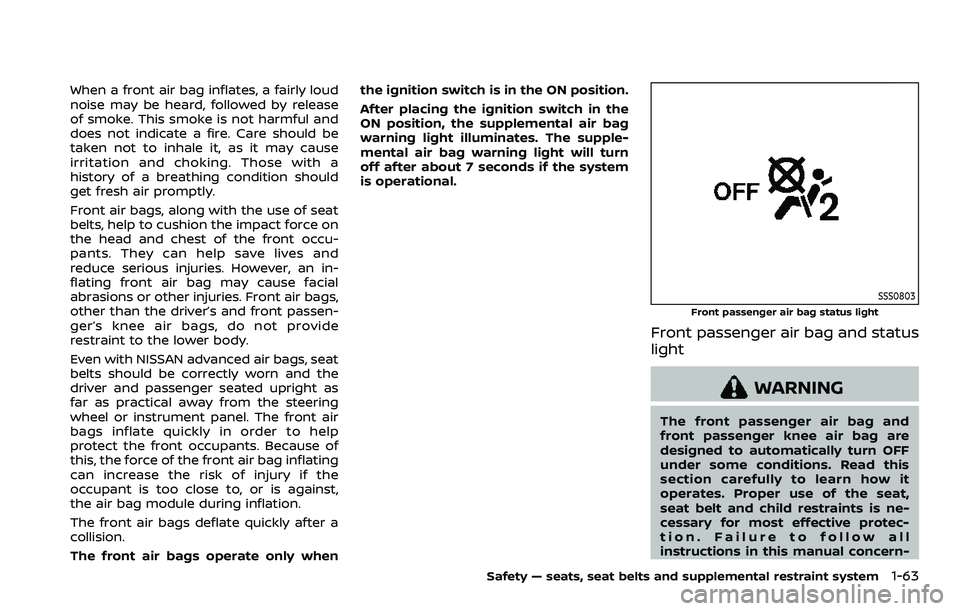2023 NISSAN ARMADA warning light
[x] Cancel search: warning lightPage 64 of 604

1-46Safety — seats, seat belts and supplemental restraint system
JVR0619X
2nd row captain’s seat
JVR0620X2nd row bench seat
Installing top tether strap
First, secure the child restraint with the
LATCH lower anchors (2nd row captain’s
or bench outboard seating positions
only).
1. If necessary, raise or remove the headrestraint or headrest to position the
top tether strap over the top of the
seatback. If the head restraint or
headrest is removed, store it in a
secure place. Be sure to reinstall the
head restraint or headrest when the
child restraint is removed. See “Head
restraints/headrests” (P.1-15) for head
restraint or headrest adjustment, re-
moval and installation information.
2. Secure the tether strap to the tether anchor point on the back of each
seatback behind the child restraint.
3. Tighten the tether strap according to the manufacturer’s instructions to
remove any slack. Make sure the head
restraint or headrest does not contact
the top tether strap.
If you have any questions when instal-
ling a top tether strap on the rear seat,
it is recommended you visit a NISSAN
dealer for this service.
FORWARD-FACING CHILD RE-
STRAINT INSTALLATION USING THE
SEAT BELTS
WARNING
. The three-point seat belt with
Automatic Locking Retractor
(ALR) must be used when instal-
ling a child restraint. Failure to
use the ALR mode will result in
the child restraint not being prop-
erly secured. The restraint could
tip over or be loose and cause
injury to a child in a sudden stop
or collision. Also, it can change
the operation of the front pas-
senger air bag. See “Front pas-
senger air bag and status light”
(P.1-63)
. When installing a child restraint
system in the 3rd center position,
both the center seat belt connec-
tor tongue and buckle tongue
must be secured. See “3rd row
center seat belt” (P.1-26).
Page 68 of 604

1-50Safety — seats, seat belts and supplemental restraint system
SSS0803
Forward-facing — step 10
10. If the child restraint is installed in thefront passenger seat, place the igni-
tion switch in the ON position. The
front passenger air bag status light
should illuminate. If this light is not
illuminated, see “Front passenger air
bag and status light” (P.1-63). Move
the child restraint to another seating
position. Have the system checked. It
is recommended you visit a NISSAN
dealer for this service.
After the child restraint is removed and
the seat belt is fully retracted, the ALR
mode (child restraint mode) is canceled.
JVR0619X
2nd row captain’s seat
JVR0620X2nd row bench seat
JVR0621X
3rd row bench seat
Installing top tether strap
WARNING
In the 3rd row bench seat, a child
restraint with a top tether strap can
only be used in the outboard seating
position (right side). Do not place it in
the outboard seating position (left
side) and center position and at-
tempt to angle the tether strap to
the outboard seating position (right
side).
First, secure the child restraint with the
Page 72 of 604

1-54Safety — seats, seat belts and supplemental restraint system
proper booster seat fit, try another
seating position or a different booster
seat.
4. Position the lap portion of the seat belt low and snug on the child’s hips.
Be sure to follow the booster seat
manufacturer’s instructions for ad-
justing the seat belt routing.
5. Pull the shoulder belt portion of the seat belt toward the retractor to take
up extra slack. Be sure the shoulder
belt is positioned across the top,
middle portion of the child’s shoulder.
Be sure to follow the booster seat
manufacturer’s instructions for ad-
justing the seat belt routing.
6. Follow the warnings, cautions and instructions for properly fastening a
seat belt shown in “Seat belts” (P.1-20).
SSS0803
7. If the booster seat is installed in thefront passenger seat, place the igni-
tion switch in the ON position. The
front passenger air bag status light
may or may not illuminate de-
pending on the size of the child and
the type of booster seat used. See
“Front passenger air bag and status
light” (P.1-63).
PRECAUTIONS ON SUPPLEMENTAL
RESTRAINT SYSTEM
This Supplemental Restraint System (SRS)
section contains important information
concerning the following systems.
. Driver and passenger supplemental
front-impact air bag (NISSAN Ad-
vanced Air Bag System)
. Driver and front passenger supple-
mental knee air bag
. Front seat-mounted side-impact sup-
plemental air bag
. Roof-mounted curtain side-impact
and rollover supplemental air bag
. Seat belt with pretensioner
Supplemental front-impact air bag sys-
tem: The NISSAN Advanced Air Bag Sys-
tem can help cushion the impact force to
the head and chest of the driver and front
passenger in certain frontal collisions.
Driver and front passenger supplemen-
tal knee air bag system: This system can
help cushion the impact force to the
driver’s and front passenger’s knees in
certain collisions.
Front seat-mounted side-impact sup-
plemental air bag system: This system
can help cushion the impact force to the
chest and pelvis area of the driver and
front passenger in certain side impact
collisions. The supplemental side air bag
SUPPLEMENTAL RESTRAINT SYSTEM
Page 73 of 604

is designed to inflate on the side where
the vehicle is impacted.
Roof-mounted curtain side-impact and
rollover supplemental air bag system:
This system can help cushion the impact
force to the head of occupants in front
and rear (2nd and 3rd) outboard seating
positions in certain side impact or rollover
collisions. In a side impact, the curtain air
bags are designed to inflate on the side
where the vehicle is impacted. In a roll-
over, the curtain air bags on both sides
are designed to inflate. Under both side-
impact and rollover situations, the curtain
air bags will remain inflated for a short
period of time.
These supplemental restraint systems are
designed tosupplement the crash pro-
tection provided by the driver and pas-
senger seat belts and are not a
substitute for them. Seat belts should
always be correctly worn and the occu-
pant seated a suitable distance away
from the steering wheel, instrument pa-
nel and door finishers. (See “Seat belts”
(P.1-20) for instructions and precautions
on seat belt usage.)
The supplemental air bags operate only
when the ignition switch is in the ON
position.
After placing the ignition switch in the
ON position, the supplemental air bag warning light illuminates. The supple-
mental air bag warning light will turn
off after about 7 seconds if the systems
are operational.
Safety — seats, seat belts and supplemental restraint system1-55
Page 74 of 604

1-56Safety — seats, seat belts and supplemental restraint system
SSS0131
SSS0132
WARNING
.The front air bags ordinarily will
not inflate in the event of a side
impact, rear impact, rollover, or
lower severity frontal collision.
Always wear your seat belts to
help reduce the risk or severity of
injury in various kinds of acci-
dents.
. The front passenger air bag and
front passenger knee air bag will
not inflate if the front passenger
air bag status light is lit or if the
front passenger seat is unoccu-
pied. See “Front passenger air
bag and status light” (P.1-63).
. The seat belts and the front air
bags are most effective when you
are sitting well back and upright
in the seat. The front air bags
inflate with great force. Even with
the NISSAN Advanced Air Bag
System, if you are unrestrained,
leaning forward, sitting sideways
or out of position in any way, you
are at greater risk of injury or
death in a crash. You may also
receive serious or fatal injuries
from the front air bag if you are
up against it when it inflates.
Page 80 of 604

1-62Safety — seats, seat belts and supplemental restraint system
system may determine a sensor
malfunction has occurred and the
front passenger air bag status
light may illuminate and the sup-
plemental air bag warning light
may flash.
. If a forward facing child restraint
is installed in the front passenger
seat, do not position the front
passenger seat so the child re-
straint contacts the instrument
panel. If the child restraint does
contact the instrument panel, the
system may determine the seat is
occupied and the passenger air
bag and front passenger knee air
bag may deploy in a collision.
Also the front passenger air bag
status light may not illuminate.
See “Child restraints” (P.1-32) for
information about installing and
using child restraints.
. Confirm the operating condition
with the front passenger air bag
status light.
. If you notice that the front pas-
senger air bag status light is not
operating as described in this
section, it is recommended you
visit a NISSAN dealer to check the
passenger seat Advanced Air Bag
System. .
Until you have confirmed with
your dealer that your passenger
seat advanced air bag is working
properly, position the occupants
in the rear seating positions.
This vehicle is equipped with the NISSAN
Advanced Air Bag System for the driver
and front passenger seats. This system is
designed to meet certification require-
ments under U.S. regulations. It is also
permitted in Canada. All of the informa-
tion, cautions and warnings in this
manual apply and must be followed.
The driver supplemental front-impact air
bag is located in the center of the
steering wheel. The passenger supple-
mental front-impact air bag is mounted in
the instrument panel above the glove
box. The front air bags are designed to
inflate in higher severity frontal collisions,
although they may inflate if the forces in
another type of collision are similar to
those of a higher severity frontal impact.
They may not inflate in certain frontal
collisions. Vehicle damage (or lack of it) is
not always an indication of proper front
air bag operation.
The NISSAN Advanced Air Bag System
monitors information from the Air bag
Control Unit (ACU), seat belt buckle sen-
sors and the occupant classification sen- sors (weight sensors). Inflator operation is
based on the severity of a collision and
seat belt usage for the driver. For the
front passenger, the occupant classifica-
tion sensors are also monitored. Based on
information from the sensors, only one
front air bag may inflate in a crash,
depending on the crash severity and
whether the front occupants are belted
or unbelted. Additionally, the front pas-
senger air bag and front passenger knee
air bag may be automatically turned OFF
under some conditions, depending on the
information provided by the occupant
classification sensors. If the front passen-
ger air bag and front passenger knee air
bag are OFF, the front passenger air bag
status light will be illuminated (if the seat
is unoccupied, the light will not be illumi-
nated, but the air bag will be off). (See
“Front passenger air bag and status light”
(P.1-63) for further details.) One front air
bag inflating does not indicate improper
performance of the system.
If you have any questions about your air
bag system, it is recommended you visit a
NISSAN dealer to obtain information
about the system. If you are considering
modification of your vehicle due to a
disability, you may also contact NISSAN.
Contact information is contained in the
front of this Owner’s Manual.
Page 81 of 604

When a front air bag inflates, a fairly loud
noise may be heard, followed by release
of smoke. This smoke is not harmful and
does not indicate a fire. Care should be
taken not to inhale it, as it may cause
irritation and choking. Those with a
history of a breathing condition should
get fresh air promptly.
Front air bags, along with the use of seat
belts, help to cushion the impact force on
the head and chest of the front occu-
pants. They can help save lives and
reduce serious injuries. However, an in-
flating front air bag may cause facial
abrasions or other injuries. Front air bags,
other than the driver’s and front passen-
ger’s knee air bags, do not provide
restraint to the lower body.
Even with NISSAN advanced air bags, seat
belts should be correctly worn and the
driver and passenger seated upright as
far as practical away from the steering
wheel or instrument panel. The front air
bags inflate quickly in order to help
protect the front occupants. Because of
this, the force of the front air bag inflating
can increase the risk of injury if the
occupant is too close to, or is against,
the air bag module during inflation.
The front air bags deflate quickly after a
collision.
The front air bags operate only whenthe ignition switch is in the ON position.
After placing the ignition switch in the
ON position, the supplemental air bag
warning light illuminates. The supple-
mental air bag warning light will turn
off after about 7 seconds if the system
is operational.
SSS0803
Front passenger air bag status light
Front passenger air bag and status
light
WARNING
The front passenger air bag and
front passenger knee air bag are
designed to automatically turn OFF
under some conditions. Read this
section carefully to learn how it
operates. Proper use of the seat,
seat belt and child restraints is ne-
cessary for most effective protec-
tion. Failure to follow all
instructions in this manual concern-
Safety — seats, seat belts and supplemental restraint system1-63
Page 83 of 604

children be properly restrained in a rear
seat. NISSAN also recommends that ap-
propriate child restraints and booster
seats be properly installed in a rear seat.
If this is not possible, the occupant
classification sensors are designed to
operate as described above to turn the
front passenger air bag and front pas-
senger knee air bag OFF for specified
child restraints. Failing to properly secure
child restrains and to use the ALR mode
may allow the restraint to tip or move in
an accident or sudden stop. This can also
result in the passenger air bag and front
passenger knee air bag inflating in a
crash instead of being OFF. (See “Child
restraints” (P.1-32) for proper use and
installation.)
If the front passenger seat is not occu-
pied, the passenger air bag and front
passenger knee air bag are designed not
to inflate in a crash. However, heavy
objects placed on the seat could result
in air bag inflation, because of the object
being detected by the occupant classifi-
cation sensors. Other conditions could
also result in air bag inflation, such as if a
child is standing on the seat, or if two
children are on the seat, contrary to the
instructions in this manual. Always be
sure that you and all vehicle occupants
are seated and restrained properly.Using the front passenger air bag status
light, you can monitor when the front
passenger air bag and front passenger
knee air bag are automatically turned
OFF with the seat occupied. The light will
not illuminate when the front passenger
seat is unoccupied.
If an adult occupant is in the seat but the
front passenger air bag status light is
illuminated (indicating that the front pas-
senger air bag and front passenger knee
air bag are OFF), it could be that the
person is a small adult, or is not sitting on
the seat properly.
If a child restraint must be used in the
front seat, the front passenger air bag
status light may or may not be illumi-
nated, depending on the size of the child
and the type of child restraint being used.
If the front passenger air bag status light
is not illuminated (indicating that the air
bag might inflate in a crash), it could be
that the child restraint or seat belt is not
being used properly. Make sure that the
child restraint is installed properly, the
seat belt is used properly and the occu-
pant is positioned properly. If the front
passenger air bag status light is still not
illuminated, reposition the occupant or
child restraint in a rear seat.
If the front passenger air bag status light
will not illuminate even though you be-lieve that the child restraint, the seat belts
and the occupant are properly positioned,
the system may be sensing an unoccu-
pied seat (in which case the air bag is
OFF). Your NISSAN dealer can check that
the system is OFF by using a special tool.
However, until you have confirmed with
your dealer that your air bag is working
properly, reposition the occupant or child
restraint in a rear seat.
The NISSAN Advanced Air Bag System
and front passenger air bag status light
will take a few seconds to register a
change in the front passenger seat sta-
tus. However, if the seat becomes unoc-
cupied, the front passenger air bag status
light will remain off.
If a malfunction occurs in the front
passenger air bag system, the supple-
mental air bag warning light
, located
in the meter and gauges area will blink.
Have the system checked. It is recom-
mended you visit a NISSAN dealer for this
service.
Normal operation:
In order for the occupant classification
sensor system to classify the front pas-
senger based on weight, please follow the
precautions and steps outlined below:
Safety — seats, seat belts and supplemental restraint system1-65